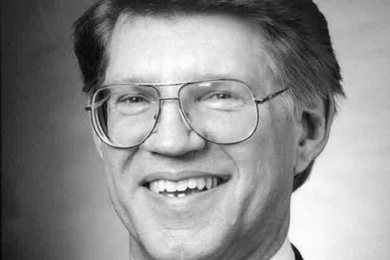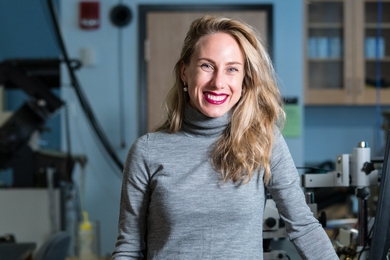Last winter, Harvard-MIT Health Sciences and Technology Director Martha Gray invited friends to join her for a Billy Collins poetry dinner. The evening would be styled after the famed haggis- and scotch-infused Robert Burns parties, she wrote in her invitation, only, like Collins' poetry, more "hospitable."
"Come step into the canoe with us," the invitation read, alluding to a quote from the former poet laureate: "Stepping from the title to the first line is like stepping into a canoe. A lot of things can go wrong."
True. But as Gray well knows, a lot of things can go right, too. In fact, it is her emphasis on what can go right that draws so many people to her. Her optimism is why, on an exceptionally snowy night in March, dozens of people flocked to her home to read poetry and to enjoy the chance meetings--an MIT student from the 1980s reunited with an engineering professor, a linguist learning the ins and outs of eBay, a physician, an artist and a writer chatting about osso bucco--that few other hosts can conjure.
This ability to bring people together has been a defining strength for Gray, who is also the Edward Hood Taplin Professor of Medical Engineering and Electrical Engineering at MIT. During her 12 years of leadership at the Harvard-MIT Division of Health Sciences and Technology (HST), which will come to a close July 1, the division has undergone fundamental transformations, almost all of which hinged on the strength of her relationships.
For instance, she turned a small, voluntary faculty into a structured and defined community of more than 60 dedicated and bona-fide HST faculty members. She expanded HST's academic programs to include novel approaches to educating biomedical innovators. And she widened HST's community by guiding the creation of HST's BioMatrix mentoring program, its alumni association, and its advisory board and council.
These accomplishments, says MIT Vice President for Research and Associate Provost Claude Canizares, "together with Martha's leadership in expanding outreach, resource development and the globalization of HST, have created a lasting legacy." Canizares has formed a search committee for the next HST director, chaired by Emery N. Brown, who has appointments at MIT and Harvard and is an anesthesiologist at Massachusetts General Hospital.
Gray's success stems from her almost innate understanding of HST. After all, Gray has been connected with HST ever since she started her career as a student in HST's Medical Engineering and Medical Physics (MEMP) doctoral program.
In 1987, she became one of the earliest HST faculty members. Her research--which contributed not just a new understanding of cartilage and how it wears, but also a new method for clinical diagnosis using functional magnetic resonance imaging--is emblematic of HST's mission. Further, when she assumed the role of HST co-director in 1995, she became the first woman to lead an academic science or engineering department at MIT.
But beyond this immersion, Gray herself personifies HST's philosophy, which puts all professions and disciplines, as she says, "on equal footing." She recognizes and fosters unexpected connections--among physicians, engineers, students, business leaders and even government officials--because of their potential to open doors to new ideas that translate into real advancements in health.
"Martha has enthusiasm, vision and a positive outlook," says Richard Mitchell, associate director of HST, "and is able to, by the strength of her personality, build relationships."
While building many new connections, Gray has also remained firmly focused on building them to better serve HST's students. "Because our students are so inspiring, I have always been motivated to do my very best to provide them with the most opportunities, the best resources and the most cutting-edge programs," says Gray.
Her efforts resulted in the doubling of the MEMP program during her tenure, as well as the addition of several new programs. The Biomedical Enterprise Program, for instance, is a first-of-its-kind, three-year master's program that trains experts in management and imbues in them a solid foundation in medical science.
"Martha supported the notion of driving translational research from the bench to the bedside and to business and back well before it became the mantra of many others," says Joseph Bonventre, the Robert H. Ebert Professor of Medicine and HST at Harvard Medical School (HMS), and Gray's co-director from 1995 until 2007.
The introduction of these novel academic programs has created a new kind of classroom environment in HST. That environment, according to Mitchell, "mixes MD students, who are comfortable with the fuzzy logic of biology, engineers, who are accustomed to equations and principles you can derive from, and business students, who wonder, 'How can I turn this into a business plan?'" The result? "Terrific cross-fertilization," says Mitchell.
Similarly, Gray created a new kind of faculty for HST that includes members from MIT, Harvard and the Harvard teaching hospitals. Their diversity adds dimension to the opportunities HST can provide to its students. Plus, says Mitchell, they send students the message: "You can do this too. You can be a PhD engineer in a hospital. You can be an MD doing full-time basic science research."
More recently, Gray has continued to expand HST's reach. In November 2007, Gray signed an agreement with the Indian government to establish a Translational Health Sciences and Technology Institute in India. HST expects its first faculty fellows from India to arrive in the fall of 2008.
HST's co-director, David Cohen, associate professor of medicine and health sciences and technology at HMS and Brigham and Women's Hospital, expects to continue to build on these foundations and to leverage the HST community to help its students put what they learn into practice. "Translational research is the way of the future," says Cohen. "HST is a paradigm for how to do it properly, for how to build relationships that will ultimately be the most beneficial to patients."
Moving forward, Gray maintains her enthusiasm for what's to come: "I'm excited about a future where collaboration is the norm and where it is commonplace for physicians, scientists, engineers and businesspeople to work together to tackle and solve our most challenging medical problems."
A version of this article appeared in MIT Tech Talk on February 13, 2008 (download PDF).






